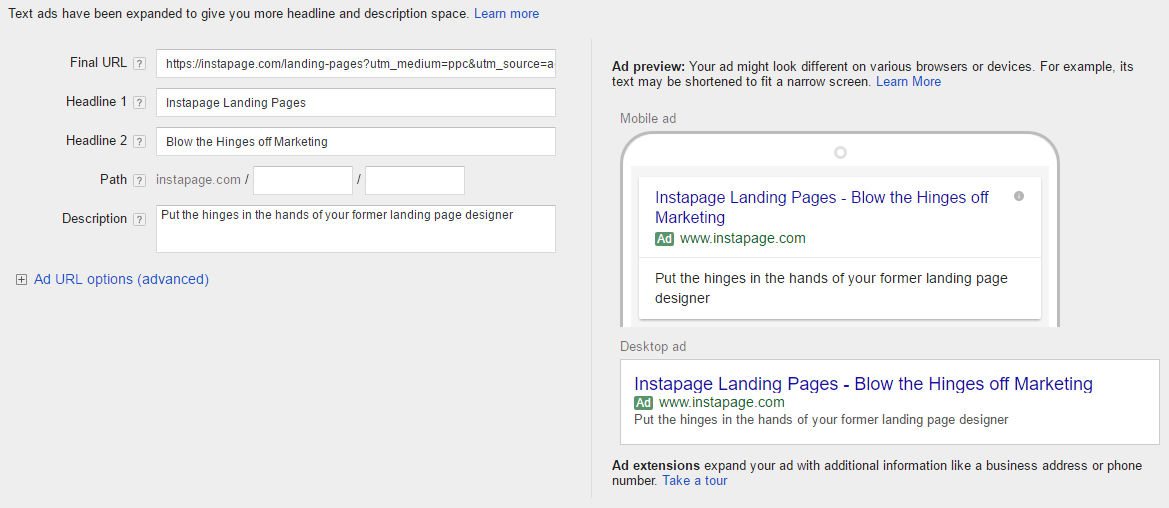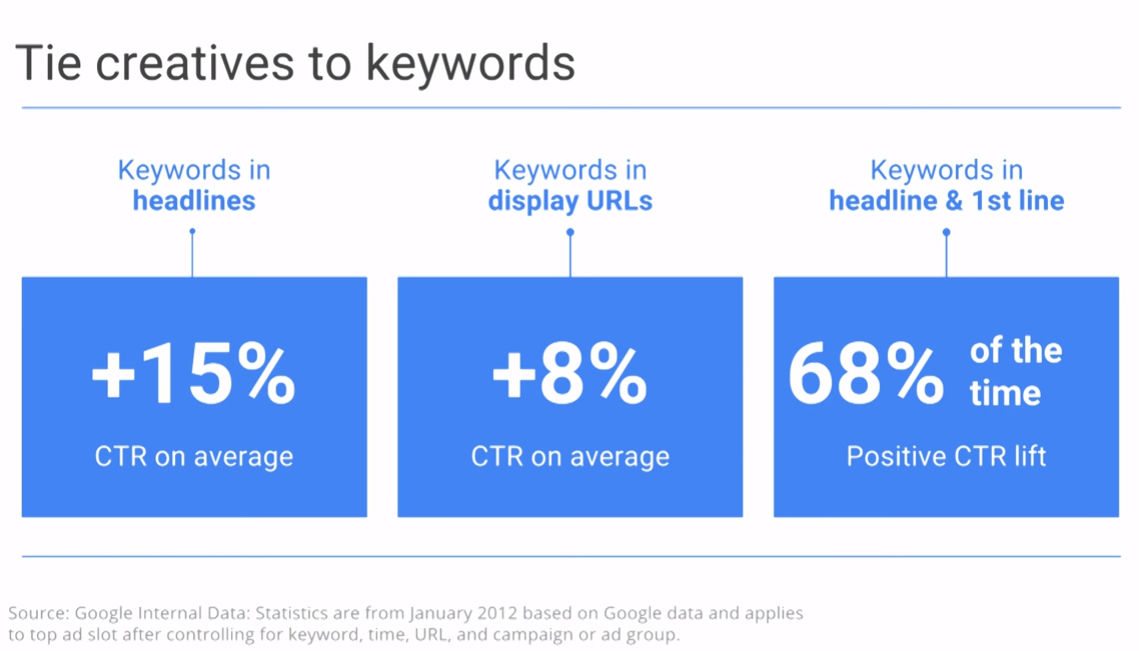Your AdWords text ads just became significantly larger, how are you going to bear the weight of this Brobdingnagian responsibility?
Worry no more; we can guide you toward expanded success with your new Expanded Text Ads (ETA). Here you will find some basics you should know to get started as well as a few tips to put you well ahead of your competitors. In the picture below, an Expanded Text Ad is displayed on the right. Notice the difference of characters available in the headline, URL, and description:

ETAs have already rolled out universally, so let’s get right into it.go
Introduction to Expanded Text Ads
For those who do not know about ETAs, Google has switched around some fields and expanded some character limits:
- There are now two headline fields each with a 30-character limit
- The two description lines have been merged into one 80-character field
- The Display URL domain populates automatically from your Final URL and provides two optional 15-character “path” fields appended to the domain
- All ETAs are mobile-optimized. The “Device Preference” prompt is a thing of the past.

You have a limited time to test
Start testing ETAs right now and there are a couple reasons why:
- As of October 26, 2016, you will no longer be able to create new standard text ads. You have less than three months to test the performance of new ETAs against new standard ads, so use that time effectively.
- It benefits you to use new features effectively as quickly as possible since it can give you a temporary advantage over competitors. People searching for relevant keywords may be more likely to click on your large, content rich ads than a competitor’s standard ads.
Now that you’re thrilled about rolling out ETAs across your account let me stop you really quick and prevent buyer’s remorse. As you roll out your new ads, moderation is the key to maintaining the performance you expect from your current ads.
Leave your current ads running
If you’re like many AdWords users, a number of different settings in your individual campaigns rely on black box algorithms. Conversion optimizer and ad rotation optimization are two such settings.
Your standard ads feed historical performance data to these algorithms to achieve your campaign goals effectively. New ads are not likely to run as successfully as your current ads at first since they do not have such robust data when created. If you replace your standard ads completely with ETAs in one fell swoop, the drop in performance can have secondary effects as well — such as your quality score.
Quality Score danger
Quality Score (QS) does not suffer automatically when creating new ads, but new ads in a completely new format may lower your average CTR. CTR is generally accepted as the strongest factor affecting Quality Score. This means that completely switching out your standard ads for ETAs will probably cause your Quality Score to suffer significantly. This increases your costs and can even push your ads off the Search Engine Results Page (SERP) if your QS suffers enough.
Inventory availability
Another rumored problem to consider are discussions that ETAs may not even be running 100% of the time at the moment.
Search Marketers on some marketing forums report that their respective Google representatives are giving varied answers about this, saying ETAs are only available to run 50% of the time, to an 80/20 split, to some thinking it is 100%.
If you are just starting out with ETAs, the safest bet is to leave some standard text ads running concurrently. If you want to accelerate the rate at which you gather data, you can change your “ad rotation” in the campaign settings to the option that reads “rotate evenly for 90 days” and then just turn off the lowest performing ads on your own rather than waiting for the algorithm. This will give each of your ads within an ad group the same amount of traffic. However, only marketers confident in their expertise should change this setting.
Lay the foundation for success
With the call to caution out of the way, we can now discuss practices that enable a successful venture into Expanded Text Ads.
Utilize proven content
Find headlines from your existing standard text ads that already work well and use them for one of the headlines in your new ETA. Remember, you have five fewer characters to work with, so you may need to tweak your headlines slightly.
For example, Reddit user hillary3q from 3Q Digital suggests using the other headline field to expand on your original headline with a feature, benefit, offer or time constraint that matches the theme of the original headline.
Try using some language from your post-click landing page in the 80-character description field. This will prime users to absorb the information on your page, and the practice can potentially increase Quality Score by improving the “post-click landing page experience” metric. This also helps message match your ad to the post-click landing page, which is another recommended tactic with paid ads.
Finally, Hillary suggests customizing the “URL path” fields to incorporate a subject or theme as your directory and the keyword as the second path field. For example, an ad about A/B Testing from Instapage might format as “instapage.com/features/ab-testing” or a shoe store can format an ad about a sale to display “shoestore.com/sale/CurryTwo.”

Fill the space that users will see
Expanded text fields are not the only new feature to text ads. Your new ETAs also face the possibility of getting truncated on certain devices. The ads may get truncated if your combined headlines get close to the character limit and have a number of wide characters like “m.”
The above image shows the possibility of Google automatically cutting off part of your text ad if the combined headlines are too long. Google recommends that advertisers “who must adhere to strict legal or regulatory ad requirements should consider creating headlines with 33 characters or less to ensure all of their ad text shows — even on the smallest devices.”
For advertisers that are not beholden to strict regulatory or legal advertising requirements, if your ad text is not truncated in the preview, it generally will not be truncated on SERPs either. With Call Extensions, your “Call” button may take the place of some of your ad text. Additionally, ETAs on the Google Display Network may not always show “Headline 2.”
General ad best practices
With ETAs as with standard ads, remember to include your keyword in your ad text. This is because, on average, including the keyword in a headline increases CTR by 15%. Title case capitalization in your headline generally increases CTR as well.

Continue to use ad extensions with your new ads. If you have not been using extensions, you need to start. ETAs take up more visible space on the SERP than standard text ads. Claim even more space with a combination of ad extensions, especially Sitelink Extensions.
How will you use Expanded Text Ads?
Expanded Text Ads are a great opportunity for more visibility on the SERP and to increase your CTR. They do not represent a guaranteed improvement, so you need to keep your advertising account in order and approach the new feature cautiously.
Use the time before October 26 efficiently and make sure you give people who click your ads the greatest incentive to convert with a highly relevant and customized post-click landing page.
